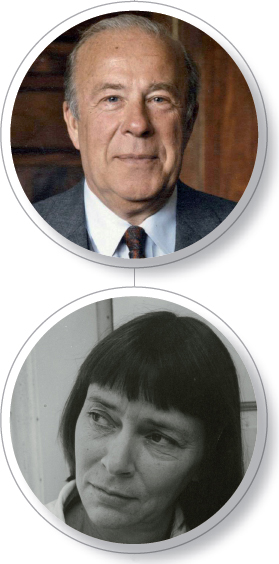Exploring American Histories: Printed Page 895
Exploring American Histories, Value Edition: Printed Page 728
American Histories: George Shultz and Barbara Deming
AMERICAN HISTORIES

As secretary of state, George Pratt Shultz presided over the end of the Cold War. A skilled mediator, Shultz believed in the brand of hard-nosed diplomacy practiced by Henry Kissinger during the Nixon administration, asserting that “negotiations are a euphemism for capitulation if the shadow of power is not cast across the bargaining table.” After graduating from Princeton with an economics degree in 1942, the twenty-two-year-old Shultz joined the Marine Corps and served in the Pacific during World War II. Three years later, Captain Shultz returned home, got married, and earned a Ph.D. in industrial economics. Shultz taught at the Massachusetts Institute of Technology and the University of Chicago and published several books on labor and wage issues. In 1955 he joined President Eisenhower’s Council of Economic Advisors, the first of many government posts he would fill.
Known for his judicious temperament and bipartisanship, Shultz, a Republican, served under Democratic presidents John F. Kennedy and Lyndon B. Johnson, as well as Republican president Richard Nixon, who appointed him secretary of labor. With Nixon’s resignation in 1974, Shultz left government for the corporate world.
In 1982 Shultz returned to Washington to serve as President Ronald Reagan’s secretary of state. Like Reagan, Shultz believed that the United States needed to reassert itself as a global power and rebound from the insecurity and self-doubt that followed the Vietnam War. The president believed that a tough approach would bring peace, and he revived the fiery rhetoric and military preparedness of the darkest days of the Cold War. As a seasoned economist, Shultz doubted that the Soviet Union was financially able to sustain its military strength, and his predictions proved correct. Faced with an escalating arms race, a fresh group of Soviet leaders decided to pursue peaceful relations, a decision that had great repercussions for the internal structure of the Soviet Union and the nations subject to its control.
While President Reagan and Secretary of State Shultz advocated confrontation with the Soviet Union, Barbara Deming challenged their efforts and devoted her life to promoting peace in a far different manner. She was born in 1917, three years earlier than Shultz, to a middle-class family living in New York City. Deming attended Quaker schools before graduating from Bennington College with a degree in theater and literature. She became an outspoken proponent of nuclear disarmament, feminism, civil rights, and pacifism. Her radical political beliefs and her recognition that she was a lesbian at the age of sixteen placed her outside the social and cultural mainstream. She lived in a women’s commune and mobilized heterosexual and gay women to demonstrate for peaceful coexistence with the Soviet Union.
In the 1980s, Deming applied her nonviolent, pacifist beliefs against Reagan and Shultz’s muscular approach to fighting the Cold War. “We can put more pressure on the antagonist for whom we show human concern,” Deming argued. As part of a worldwide campaign against the deployment of nuclear weapons, she joined the Women’s Encampment for a Future of Peace and Justice, which opened in western New York in 1983 next to an army depot that stored nuclear missiles. On July 30, 1983, Deming led a march of seventy-five women from the camp into the small town of Waterloo. “Four miles into our walk,” she recalled, “our way was blocked by several hundred townspeople brandishing American flags and chanting, ‘Commies, go home!’” The marchers then sat down in the style of nonviolent protest and engaged their opponents in dialogue to no avail, as the police arrested Deming and fifty-three other protesters. Demonstrations continued throughout the rest of the summer, inspiring protests in other American communities and throughout Europe. •
THE AMERICAN HISTORIES of George Shultz and Barbara Deming were shaped in profound ways by decades of conflict between the United States and the Soviet Union. Both Shultz and Deming believed that the conflict was one of the defining issues of their times, and both were convinced that their approach was the best way to achieve lasting global peace.
The Cold War that Shultz and Deming were dedicated to ending underwent significant changes in the decades following the Nixon administration’s reduction of tensions with the Soviet Union. In the late 1970s, President Jimmy Carter emphasized the moralistic diplomacy of human rights, but by the end of his term he had increased the size of the U.S. military in response to Soviet aggression in Afghanistan. His successor, Ronald Reagan, employed harsher rhetoric and accelerated the military buildup begun under Carter. However, Reagan would have been far less successful had it not been for the willingness of Soviet leader Mikhail Gorbachev to join him in ending the Cold War. With the ultimate collapse of the Soviet Union and its empire, the United States became the world’s sole superpower. At the same time, the United States had to operate in an increasingly globalized world. Embracing new challenges, the United States tested its strength in Central America, the Middle East, and the Persian Gulf.